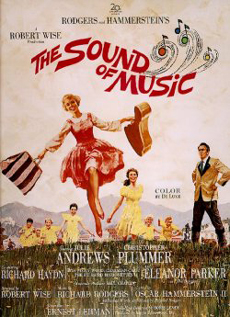The movie begins with sweeping vistas of the Austrian countryside and
then the camera swoops in to Maria, the spirited nun postulant, singing
and dancing on top of a hill. Incidentally, that was the last scene
shot on location, though it's the first one in the movie. The film was
shot both on location in Salzburg, Austria, and on Hollywood sound stages
(primarily for the interiors).
Maria (Julie Andrews) is not fitting in at the convent, so she gets
sent to serve as a nanny for the Von Trapp family, which consists of
the widower, Captain Von Trapp (played by Christopher Plummer), and
seven children. As you might imagine, this is no easy task. But Maria
soon charms the children into behaving for her, teaching them something
about music, and winning over their hearts, as well as that of their
stoic father.
In the scene where the children are singing "Edelweiss" and
their father joins them, connecting with them for the first time, the
actors who played the children were genuinely moved. Plummer, like his
counterpart, was not terribly comfortable with children. When he sang
with them, the children got a first sense that "He really likes
us." Particularly in the case of some of the younger children,
the emotions seen on the screen are real.
Another interesting story from the shooting: during the song "Sixteen
Going on Seventeen" in the Gazebo, Charmian Carr as Liesl slipped
while leaping across a bench and fell through a pane of glass. Her ankle
was hurt, and she finished the scene with a bandage wrapped around her
leg. The restored version of the film, however, erases the bandage.
Incidentally, Carr was actually 21 when she made the movie, just six
years younger than Andrews.
Of course, by the time we've reached what would typically be a happy
ending, the movie is only about halfway through. The second half deals
with the more serious, weighty subject of the growing threat of World
War II and German occupation. The Von Trapp family must figure out a
way to escape the consequences. Many people have seen this movie countless
times, but in case some reading this review have not, I won't reveal
how they do so.
What can I say about The Sound of Music that hasn't been said
already? There's a reason this movie is replayed so often. The terrific
music score, the exceptional performances, the beautiful locations,
the entertaining dialogue. For that, there are many people to thank.
The idea actually came, in part, from actress Mary Martin, who was set
to be in a play written by Howard Lindsay and Russel Crouse. Originally,
the play was supposed to use songs that had been sung by the real Von
Trapps, but Mary asked Rodgers and Hammerstein to write her an original
song. They were in the middle of working on something else, but after
they finished it, they took up the project. They ended up writing, not
just one song, but an entire score.
Mary Martin originated the role on the stage. She tried to get Christopher
Plummer to play Captain Von Trapp, but it was determined he was too
young to play opposite Mary Martin, who was 16 years older than him.
Plummer did, of course, play the role in the film.
Julie Andrews seemed destined to play this role. When she was passed
over for My Fair Lady, a role she'd originated on stage, she
happily took the opportunity to star in The Sound of Music. This
turned out to be a very good thing for her.
In a testament to the craftsmanship of this movie, it is often referred
to in popular culture. Most recently, this
fantastic gonzo performance of "Do Re Me" at a train station
in Antwerp. Parodies of scenes from the music have also appeared in
such shows as The Simpsons and Family Guy, among many
others. If you ever get a chance, I highly recommend attending the
singalong Sound of Music, which is a lot of fun.
Why is this film so beloved? The Sound of Music does what so
many have tried to do and few actually manage to do. That's to create
a film that is both joyous and touching. It's hard not to love the scenes
of Maria singing with the children, hard not to fear for the Von Trapps
during the Nazi occupation scenes.
That's the wonderful thing about Rodgers and Hammerstein. They know
how to blend lightness and depth, to access every emotion through the
magic of music.


